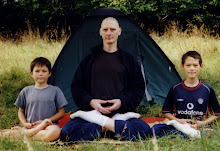The original two Chinese characters read in Japanese as TAISESHIMEN are reproduced and explained in the exposition of Fukan-zazengi Shinpitsu-bon on my webpage.
The first character, REI, means to order, to cause, to bring about. In Japanese it is read as the causitive form of SURU -- SESHIMURU.
The second character, TAI [SURU], means to oppose.
Master Dogen's instruction, in both the former and later versions of Fukan-zazengi, is to cause an opposition between ears and shoulders, and between nose and navel.
In 1994, when the Nishijima-Cross version of Fukan-zazengi was published in Shobogenzo Book 1 -- before I had been introduced to the discoveries of FM Alexander concering habitual human misconceptions about proper posture -- I could not understand the true meaning of Master Dogen's words.
So the translation we chose in 1994 was this: "The ears must be aligned with the shoulders, and the nose aligned with the navel."
This translation may not actually be so bad. TAI SURU can also be understood as having to do with alignment.
In general, the reason my Errata list is not much longer than it is, is that I always tried to make the Nishijima-Cross translation as literal as possible. So even in parts that I didn't understand then, or don't understand now, there may still be hope of Master Dogen's original meaning gettting through the dirty filter of my ignorance.
But what I can say without doubt or hesitation is that the understanding of Master Dogen's words that I had in 1994 has been totally falsified by being introduced to the discoveries of FM Alexander. My understanding of what I should do and what I should not do, what I should think and what I should not think, to bring about the opposition Master Dogen described, was totally wrong.
Years ago I was privileged to attend a series of Alexander workshops with an experienced Alexander teacher, and very open person, who had recently lost her husband. As soon as the master-teacher who was leading the workshop would put hands on her, Maureen would burst into tears, and then go and curl up with a blanket.
Looking back now, as a specialist in all kinds of inner ear problem, I see that the tearful outburst was supported by Moro I, the opening out phase of the baby panic reflex, and the blanket-cuddling was supported by Moro II, the closing/grasping phase of the baby panic reflex.
But I am not using Maureen's example as an example of vestibular dysfunction. On the contrary, what left a deep impression on me about Maureen's behaviour was the simplicity and purity of her reaction. Her reaction, in its lack of sophistication, was beautiful and full of truth. What Maureen demonstrated was NOT trying to be right, NOT trying to control her grief, NOT trying to line herself up symmetrically. What Maureen demonstrated to me, rather, was what it is to allow something spontaneous to happen.
I used to understand that Master Dogen's instruction was about control, about symmetry, about me bringing myself into alignment like a soldier on the parade ground. But Alexander work has caused me to realize, little by little, how very wrong that understanding was.
Monday, 17 March 2008
Subscribe to:
Post Comments (Atom)

No comments:
Post a Comment